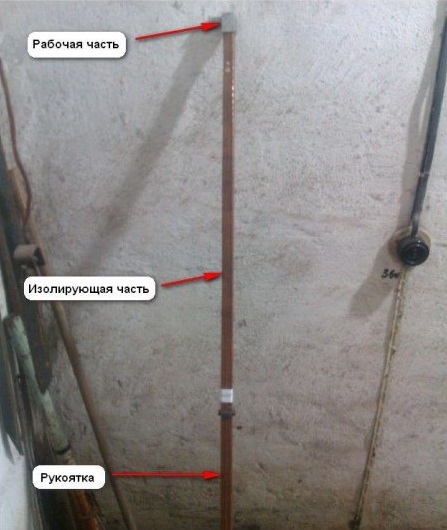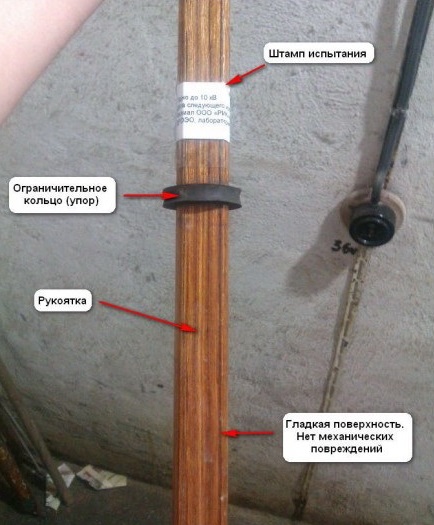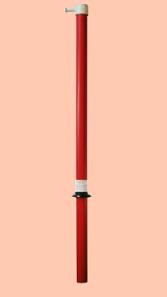Operational rod. Operating insulating rods
Purpose. An insulating rod is a rod made of insulating material with which a person can touch live parts of an electrical installation without the risk of electric shock. The rod is the main insulating electrical protective agent those. it can withstand the operating voltage of the installation for a long time. The rods are used in installations of all voltages. Depending on their purpose, rods are divided into four types:
A) operational(TYPE SHO-10u1, SHO-35U1, where SHO is an operating rod, the numbers indicate voltage in kV). They are used for operations with single-pole disconnectors and the application of temporary portable protective grounding, for removing and installing tubular fuses (ShR - 11OU1), checking the absence of voltage and other similar work.
b) measuring(type SHI-35/110U1, SHI – 220U1). Designed for measurements in electrical installations in operation (checking the voltage distribution across the insulators of a garland, determining the resistance of contact connections on wires, etc.)
V) repair Serve for the production of repair and installation work near live parts that are energized or directly on them: cleaning insulators from dust, connecting to consumer wires, trimming tree branches in close proximity to wires, etc. An example is the ShPK-10 rod for puncturing cables. It is designed to check the absence of voltage on the cable up to 10 kV at repair work ah by piercing it to the current-carrying conductors in order to prevent electric shock to personnel in the event of voltage on the cable.
G) universal(type SHOU-35, SHOU-15, SHOU-110). Their design makes it possible to perform various operations, including many of those for which operating rods are intended.
Design– each rod has three main parts: a working insulating part and a handle.
Working part determines the purpose of the bar. It is made from tubes with a diameter of 30 - 40 mm made of bakelite, fiberglass and other plastics, as well as wooden rods impregnated with drying oils (linseed, hemp, etc.). The length of the insulating part of the rod should be such as to eliminate the risk of it overlapping to the surface at the highest possible stresses acting on the bar. The shortest length of the insulating part of the rod depends on the voltage of the electrical installation and is determined according to GOST 20494-75yu
Lever Designed for holding the barbell by hand. As a rule, it is a continuation of the insulating part of the rod and is separated from it by a restrictive ring.
Terms of use. Rods should be used in closed electrical installations. On outdoors their use is allowed only in dry weather. The barbell may only be operated by qualified personnel trained in this work. As a rule, a second person must be present to monitor the operator’s actions and, if necessary, provide assistance. When working with a barbell, you must wear dielectric gloves. Without gloves, you can only work in installations up to 1000V. When working, do not touch the rod above the limited ring. The frequency of electrical tests of rods (except for measuring ones) is once every 24 months, for measuring during the measurement season, once every 3 months, but less than once every 12 months.
2.2.Insulating pliers.
Purpose insulating clamps - performing live operations with fuses, installing and removing insulating pads, etc. work. Clamps are used in installations up to 35 kV inclusive.
Constructions Flares are different, but in all cases they have three main parts: the working part, or jaws, the insulating part and the handles. The dimensions of the working part are not standardized. However, the dimensions of the metal working part should be as small as possible in order to prevent accidental short-circuiting of current-carrying parts to each other or to grounded parts. The length of the insulating part for electrical installations up to 1000 V is not standardized and is determined by the convenience of working with them, and above 1000 V is determined by the operating voltage of the installation.
Terms of use. Insulating pliers can be used in closed electrical installations, and in open ones only in dry weather. In electrical installations above 1000V, the worker must wear dielectric gloves, and when removing and installing live fuses, wear safety glasses. The frequency of electrical tests of clamps is once every 24 months.
The profession of an electrician is extremely difficult. Working under high voltage can lead to bad consequences. Products are being developed specifically for people from this professional field. personal protection. One such item is an insulating rod. In this article we will tell you what an insulating rod is, show its types in the photo, conduct electrical tests and discuss in detail the direct purpose of this device.
What is an insulating rod: starting with the concept
An insulating or grounding rod is a special tool made in the shape of a stick. Has a handle and a tip. The handle is made of non-electrically conductive elements such as wood, ebonite, etc. The top is impregnated with flax or hemp oil and coated with non-conductive varnish.
At the end there is a metal rod, which can be made in the form of a hook, ring and other geometric shapes. It all depends solely on the purpose of the tool.
A restrictive ring is provided between the handle and the tip. Its function is to prevent, through inattention, the non-insulated end of the bar from coming into contact with the hand. According to GOST, the restrictive ring must protrude at least 10 mm from the diameter of the rod.
The function of the insulating rod is quite diverse - from any work on tearing out live cables, to basic support. According to the rules, in installations in which the voltage is more than 350 kW, two electricians must work. One of the craftsmen holds parts of the wires with a special holding device - an insulating rod.
The length of the tool depends on the voltage with which it is intended to work, according to GOST. The maximum permissible weight of the tool is 8 kilograms.
Scope of application of the insulating rod
Work is carried out on any electrical installations in the premises. The tool allows you to replace fuses, work with connectors, and free people struck by electric shock.
Important to know
Never work with an insulating rod outdoors in rainy or humid weather. There is a risk of electric shock.
The scope of application will be described in more detail in the classification.
Types of insulating rods

Since the scope of application is quite wide, the tool has various types and modifications. For each purpose there are special tips according to the required functions.
Operational
There are four types of isolating surgical rod:
- Operationally insulating. Used for many jobs because the design allows you to change the tip depending on the task. Suitable for use in installations with alternating or direct current with voltage up to 220V.
- Rescue. Used to rescue a person from an electric shock zone up to 110V. Allows you to quickly provide first aid, thereby increasing the chances of saving the victim.
- Universal insulating rod. Used similarly to the operational isolating class. The difference is that it has wider functionality.
- Grounding rod. Also used in electrical installations with voltages up to 220 kV with direct or alternating current. This device allows you to work in areas with residual voltage or partial shutdown of the installation.
The operating rod allows for all types of electrical work. The main thing is to use the tool carefully and as intended, reducing the risk of various injuries from exposure to electricity.
“Pliers”
It should be distinguished as a separate subspecies. The tool allows you to replace fuses and other elements. The device involves special teeth that can move when exposed to the working element.
The tip can be replaced, turning the pliers into an operating rod. The tips must be rubberized so as not to damage the cartridge when replacing.
Measuring

Used to measure the effects of current. Allows you to determine current strength, voltage surges and more. A special head, configured in laboratory conditions, is connected in parallel to the device and detects minimal changes when current is applied.
There are three types:
- Universal measuring rod. IN this device It is possible to change the distance between the electrodes, which allows you to most accurately obtain measurement data.
- Measuring rod. In such devices, a dial microammeter with low resistance is installed. You can change the set of indicator probes. The probes are placed on the controlled insulator, and a parallel connection occurs. The sensor needle shows the results.
- Electrical clamps. Essentially the same clamps, but with the ability to measure current and voltage.
Terms of Use
In order to avoid adverse consequences, the devices must be used in accordance with the operating instructions, so carefully read the instructions for the device.
Only the main provisions are indicated here.
Do not forget that each manufacturer makes a unique device. The principles of its operation may differ from analogues. Please read the following rules carefully:
- The operating temperature of the device is from minus 40 degrees to plus 45.
- It is prohibited to use a device that does not have a quality certificate. Such a device may malfunction and cause harm to both the electrical structure and you personally.
- Do not use the tool in humidity conditions greater than 98% at a temperature of 25 degrees. Do not work in rain, snow, fog or other atmospheric conditions that involve high humidity.
- Avoid using unstable supports such as stepladders or scaffolding. Use a stable ladder or manipulator if necessary.
- People with a certificate or permit are allowed to work. The employee is required to use dielectric gloves and boots. It is also necessary to wear a dielectric work uniform special purpose, glasses and respirator. This way you will be more protected from electric shock.
Each time, before carrying out work, do a visual inspection of the rod. If any flaws are found, use another tool. This is mandatory and generally accepted for everyone.

No testing or testing is carried out during operation. There are only scheduled tests that are done regularly, after a designated period. In rare cases, unscheduled inspections are carried out after the device has been dropped or returned from repair.
Testing an insulating rod
According to GOST, the rod must undergo inspections during production. Since working with tools is classified as dangerous, therefore the test must have the strictest rules.
The test is carried out at the factory under the supervision of specially trained people who check each product.
If the manufacturer has mass production, then so-called type tests are carried out. The idea is to check three instruments of each subtype.
- Visual control. Checked for external defects.
- Checking compliance with factory drawings. Using certain laser technologies, complete dimensional conformity is verified.
- Checking electrical insulation for strength. Carried out under the influence electric current. A high voltage is applied to the rod and if the tool is not subject to potholes and there are no dielectric losses, the test is passed.
- Tensile test. A load is attached to the ends on both sides. If there is no damage, the test is considered successful.
- Bending test. The rod is exposed to the center, being secured on both sides. If there is no damage, proceed to further tests.
Conclusion
Now you know everything about electric booms, their production, types and tests. Pay attention to your work and always use special protective clothing. This will not only help protect against injury, but also save life.
When carrying out electrical work special attention pays attention to the safety of installers and service personnel. Electric shock can be fatal under certain conditions. In order to prevent such incidents, various protective devices and tools are used. Among them are operational insulating rods, which are intended for use both during operational work in electrical installations and for carrying out rescue operations. More on this below.
Types of operational insulating rods and their purpose
The VELSnab company offers to purchase four types of operational insulating rods:
|
SHO rod The SHO rod (operational insulating rod) is intended for carrying out operational work in various electrical installations of alternating or DC voltage up to 220 kV. SHO rods are used to turn on/off single-lane disconnectors. They can also be used for other operations due to the fact that various tools and attachments can be mounted on the bar. SCO bar The SCO boom (operational rescue boom) is intended for rescue operations. With its help, you can pull a person out of the zone affected by current voltages from 0.4 to 110 kV. The SCO bar can literally save a person’s life, as it allows him to be pulled to a safe distance from the electrical installation without waiting for it to be disconnected from the network. After this, you can begin resuscitation efforts, in which every second counts. SHOW rod The SHOU rod (universal operational rod) is intended for carrying out operational work in various electrical installations of alternating or direct current with voltage up to 220 kV. Rods of this type are used to turn on/off disconnectors, as well as replace tubular fuses. The bar is also designed for additional installation various tools and devices that expand its functionality. ShZP rod The ShZP rod (operational rod for applying grounding) is intended for applying portable grounding in electrical installations of alternating or direct current with voltage up to 220 kV. The use of a ShZP rod allows you to quickly install a portable ground electrode and provide additional safety and protection from electric shock. |
Other uses of operating rods
In addition, rods are used to clean electrical installations and insulation from dust or dirt. Using rods, they check the presence or absence of voltage, control the degree of vibration of tires and carry out other planned operations that would be impossible to carry out without the use of operational rods.
Design of operating rods
Any operating rod consists of three parts:
- working part;
- insulating part;
- grip handle.
The working part of the rod is made of metal tips that differ in shape depending on the purpose of the operating rod. The insulating part is an element of the operating rod consisting of insulating material. The grip handle is the part of the rod that is directly in the operator’s hands. It is also made of insulating material.
Operating conditions for operating rods
The rods are designed for the following operating conditions:
- the temperature at which the rods are operated ranges from minus 45 o C to plus 40 o C;
- the humidity at which the booms are operated should not exceed 80%
- rated voltage electrical installations for each brand of rod are indicated separately.
Advantages of purchasing operating rods from VELSnab company
Operating rods made from reliable and high-quality materials can be purchased from VELSnab. The company offers customers to buy electrical equipment, fittings for overhead lines and self-supporting insulated wires, installation tools, as well as protective equipment at attractive prices. VELSnab's pricing policy is determined by the fact that the company directly cooperates with equipment manufacturers, purchasing large quantities of products.
In addition, VELSnab provides free delivery of purchased goods to the terminals of transport companies. If you need to deliver goods to the territory of the Moscow region or Moscow, then you can order this service from the company for a small price. VELSnab tries to create favorable conditions for cooperation and enter into the position of the client, therefore, regular customers, if necessary, are given the opportunity to defer payment for purchased products.
Resume
Operating rods are designed to carry out safe operations on servicing electrical equipment. In addition, they are used for rescue operations.
VELSnab company, which occupies one of the leading positions in the domestic specialized market, offers high-quality operating rods at an attractive price.
Working with live electrical appliances is a high-risk activity. Failure to comply with safety precautions may result in electric shock to the installer and cause irreparable damage to health, and in exceptional cases lead to death. That is why, when carrying out repair and installation work under voltage, much attention is paid to safety. For this purpose, certain ones are used, among which the insulating rod occupies a special place.
An insulating rod is a rod made from raw materials that does not conduct current. With their help, you can touch areas of operating equipment without the risk of electric shock. The maximum voltage threshold at which the rod can be used is 550 kV. Most often, this tool is used during rescue operations.
According to the classification, insulating rods can be divided into measuring and operational. Operational rods also include repair and universal rods.
Design and technical characteristics 
Any barbell model, regardless of the type, includes three main parts:

For the production of insulating rods, metal is used exclusively for connecting parts of the device, as well as for constructing the structure work area(if necessary). In this case, the ratio of the lengths of metal inserts and the insulating part should be no more than 1:20.
When producing rods, a stop is installed between the handle and the insulating part. At the same time, this condition is mandatory both for homogeneous parts of the product and for composite ones. This is done for the sole purpose of preventing an electrician from accidentally touching the insulating part. Under no circumstances should you apply paint that will act as a border between the handle and the insulating element; working with such a rod is unacceptable. 
Operating rods
This type of insulating rods is necessary for changing fuses in equipment with an operating voltage of more than 1 kW, checking the presence of voltage, and switching single-pole disconnectors. They are divided into several types:

Measuring rods

This type of rod is designed to take voltage measurements and monitor the quality of contact connections, which will allow you to monitor the performance of installations. They fall into two main categories:
- Shiu bar. The main purpose of this type of rod is to measure the distance between the electrodes. This makes it possible to determine the operating voltage on the insulators.
- SHI bar. Allows you to accurately measure voltage on contacts or insulators using a microammeter. Depending on the operating voltage, a corresponding set of probes is installed on them.
Safety precautions
The worker must ensure that when measuring voltage or carrying out repair work, the rod does not come close to the grounding elements.
All work must be carried out on the surface of the earth or on devices with a large area. In the case of using ladders, etc., there is a possibility of loss of balance and the worker may touch the working area of the equipment, which can lead to disastrous consequences.
The rod in the work area should be carried only in a horizontal position, and its components should be assembled directly at the work site.
If the insulating rod is long, the work should only be carried out by two electricians. This will make it easy to hold the barbell.
When working with a barbell, the use of dielectric gloves is required.
It is strictly prohibited:
- Carry out work during precipitation and high humidity.
- Use rods that have not been tested by the relevant services.
- Work with rods that have visible or invisible faults or damage.
Universal rods ШИУ are designed for attaching interchangeable tools. The rods have a unified working part on which they can be installed: a scraper attachment for operational work, a universal attachment for operational work, a pointer high voltage with light and sound indication.&nbs..
Universal rods ШИУ are designed for attaching interchangeable tools. The rods have a unified working part on which they can be installed: a scraper attachment for operational work, a universal attachment for operational work, a high-voltage indicator with light and sound indication. ..
Designed for operational work in electrical installations of permanent and AC frequency 50 Hz and voltage up to 330 kV for controlling disconnectors, as well as for replacing tubular high-voltage fuses. TECHNICAL DATA..
Designed for operational operation in electrical installations of direct and alternating current with a frequency of 50 Hz and voltage up to 1 kV. Used to switch on and off single-pole disconnectors. The working part of the rod structurally makes it possible to ensure reliable fastening of replaceable devices.
Insulating rods of the ShZP type are intended for the application of portable grounding in electrical installations of direct and alternating current with a frequency of 50 Hz and voltage from 1 to 220 kV. The insulating rods ShZP-10/15 and ShZP-35 are made of PVC pipes, and the insulating rods ShZP-110 and ShZP-220 are made of fiberglass. D..
Designed for operational operation in electrical installations of direct and alternating current with a frequency of 50 Hz and voltage from 1 to 10 kV. The rod consists of a working part, an insulating part, a handle (the handle is combined with the insulating part) and two metal links connected by half-couplings. &nbs..
Designed for operational operation in electrical installations of direct and alternating current with a frequency of 50 Hz and voltage up to 15 kV. Used to switch on and off single-pole disconnectors. The working part of the rod structurally makes it possible to ensure reliable fastening of replaceable devices..
Designed for operational operation in electrical installations of direct and alternating current with a frequency of 50 Hz and voltage up to 220 kV. Used to switch on and off single-pole disconnectors. The working part of the rod structurally makes it possible to ensure reliable fastening of replaceable devices..
Designed for operational operation in electrical installations of direct and alternating current with a frequency of 50 Hz and voltage up to 220 kV. Used to switch on and off single-pole disconnectors. The working part of the rod structurally makes it possible to ensure reliable fastening of replaceable devices..
